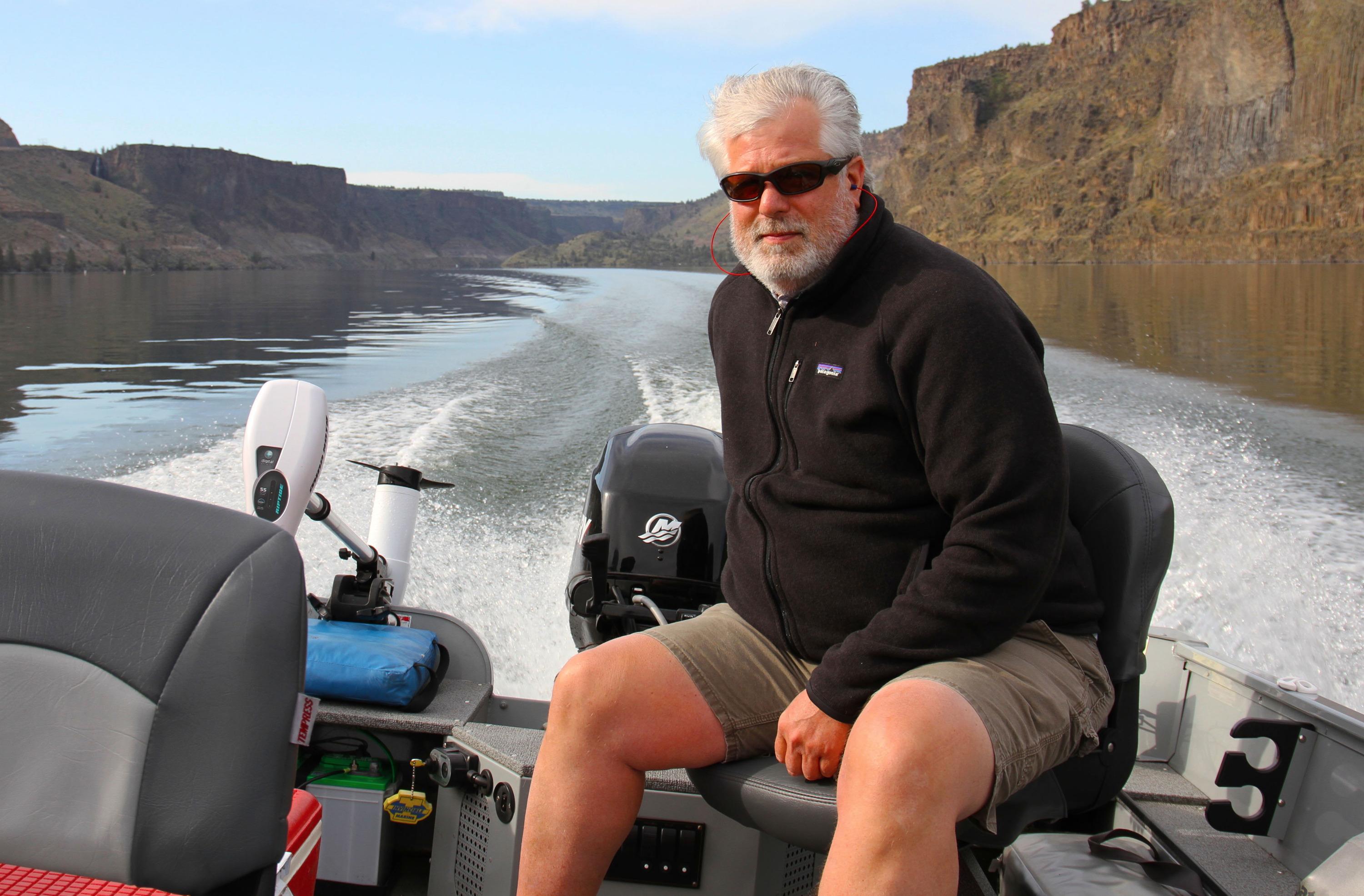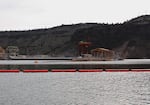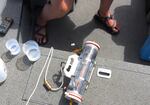
Conservationists Greg McMillan believes that Oregon's Department of Environmental Quality is being too lax with regulating Portland General Electric for water quality standards on the lower Deschutes.
Amanda Peacher / OPB
Update: The Deschutes River Alliance formally filed suit Friday, Aug. 12, 2016 against Portland General Electric over alleged water quality violations.
Greg McMillan peered into the Metolius River on a chilly May morning. As he does three times a month, the president of the Deschutes River Alliance dropped a water collection device off the side of his powerboat.
“The water clarity here is just amazing,” McMillan said as he retrieved a sample.
He measured temperature, pH and turbidity of the river water. Meanwhile, an osprey flew overhead, clutching a small fish in its talons. Every few minutes, a silvery kokanee flung itself above the surface of the river.
The water quality results were excellent, as expected. The Metolius was clean and cool.
Later that day, McMillan would also sample the other tributaries of the lower Deschutes River. Those rivers would not be so clean and cool.
Water Quality Solution That Falls Short?
A few miles downstream, the Metolius joins with the Middle Deschutes and Crooked Rivers. The tributaries pool in Lake Billy Chinook behind Round Butte Dam, one of three in a complex that produces enough energy to power the city of Salem.
It’s in this reservoir that the clear, clean Metolius water meets and clashes with the warmer, dirtier waters of the other two tributaries. This body of water is also where human perspectives clash. It’s the source of a yearslong conflict about how agencies and dam operators should manage water quality in the lower Deschutes River.
Until 2009, what came out of the bottom of the Round Butte Dam was from the Metolius River — clear and cold, as Greg McMillan’s early summer tests confirmed. The water flowed through the electricity-generating turbines at the bottom of the reservoir.
That meant that in the spring, the released water was colder than it would be without the dam. In the late summer, it was warmer than natural river temperatures, according to Oregon Department of Fish and Wildlife.
In 2005, when Portland General Electric applied for a new 50-year operating license for the dam project, the state and other environmental groups asked the utility to figure out how to keep the temperature downriver more balanced. At that time, the Warm Springs Tribes also became a joint licensee for the project, though PGE continued to operate the dams.
PGE and the tribes agreed to spend about $110 million to install a water mixing tower in the reservoir behind the dam. The giant device, also called a “selective water withdrawal tower,” pulls warm water from the reservoir’s surface to blend with cold water from the bottom. The discharge that ultimately emerges from the dam is a warmer blend from the three tributaries. The blended water is intended to create habitat that’s healthier for fish.
Watch this video to understand how PGE's selective water withdrawal tower works:
“The river now is warmer beginning in early winter through spring and then cooler late summer, early fall,” said Rod French, fisheries biologist with Oregon Department of Fish and Game. “We feel that that's the natural regime that these fish evolved with over time.”
But five years after the installation of the mixing tower, the one-of-a-kind device has produced mixed results. PGE says it works for temperature regulation. The utility falls short, though, on other water quality measures.
The Deschutes River Alliance alleges that since the installation of the device, PGE has violated water quality standards more than 1,200 times without serious consequence. That finding is based on PGE’s own water quality tests. The conservation group also believes that Oregon’s Department of Environmental Quality, which regulates water quality, has developed an overly cozy relationship with PGE and that regulators are lax in enforcing standards.
Fishermen say the changes have disrupted world-class trout and steelhead fishery and damaged water quality in 100 river miles of the lower Deschutes.
“It Was Going To Be A Good, Happy Story.”
The underwater mixing device was supposed to be an innovative, one-of-a-kind fix. According to PGE, it’s the only tower of its kind anywhere in the nation.

A view of the selective water withdrawal tower from behind Round Butte Dam. The 273-foot underwater device mixes warm reservoir surface water with cold bottom water.
Amanda Peacher / OPB
“We expected this to be a fairly simple thing to implement because it was just going to be a good happy story,” said Eric Nigg, the state’s water quality manager for Central Oregon. “It has been more complicated than that.”
As part of the lengthy process of crafting a new dam license, DEQ and other groups set standards for water temperature below the dams. The agreement also laid out standards how much oxygen needed to be in the water so that fish can breathe and also for pH, or the acidity or alkalinity of the water.
But since the mixing device was installed in 2009, PGE has struggled to meet all of those standards. Water temperature wasn’t a problem, but the utility found it wasn’t always able to get the levels of pH and dissolved oxygen right.
In a 2013 email, a PGE official asked regulators to lower one standard. At the time, PGE was spilling water over the dams to aerate the river to try to meet dissolved oxygen requirements. When dam operators spill water instead of sending it through the turbines, the utility loses generation profits.
State regulators approved the lower standard requested by PGE.
“It just looks like DEQ was trying to be very accommodating to what PGE was asking for,” said Rick Hafele, a retired DEQ water quality manager who now serves on DRA’s volunteer board. “Rather than looking at what is best for the stream, they were looking at what’s best for the project that PGE's been spending a lot of money on."

Conservationists attribute the growth in algae blooms in the lower River to the changes brought by PGE's water mixing device installed in the reservoir.
Courtesy DRA
Technically DEQ could fine PGE (or any regulated company) $30,000 per day for violating water quality standards. But DEQ officials say that because the mixing device is still relatively new, and because PGE is cooperative, they’re comfortable giving the utility time and flexibility.
The Deschutes River Alliance activists are fed up with flexibility. They say PGE has violated water quality standards more than 1,200 times since the mixing device went in seven years ago.
DEQ officials say that’s an exaggeration.
“It isn't necessarily considered a violation every day when they don't meet a standard,” Nigg said. “I think at this point the important part is that they're continuing to try and understand the system.”
And PGE leaders note that they’re doing everything DEQ has asked. “We work really closely with our water quality regulators,” said Steve Corson, a utility spokesman. “We believe that we are in compliance.”
The Deschutes River Alliance also criticizes DEQ for changing water quality standards below the dam without going through a public process.
“They developed the agreements behind closed doors in secretive proceedings,” McMillan said. “There was zero notification.”
From DEQ’s perspective, their regulators are being flexible with a cooperative partner in crafting interim agreements.
“We don't think it has subverted the proper public process,” Nigg said.
From the Deschutes River Alliance’s perspective, DEQ is too soft on dam operators.
“My primary concern is that the regulatory agency is not regulating,” McMillan said. “Instead of regulating, they're enabling.”
Corson, with PGE, said his company could be criticized no matter what its relationship is with DEQ.
"If you collaborate or cooperate with your regulator, then people say you're too close," said Corson. "But if you have an adversarial relationship with them, then people say that's a problem.”
And recently, state regulators have been strict with the utility on another issue. This spring, DEQ did raise questions about a PGE report on macroinvertebrate populations, or aquatic bugs, below the river. PGE reported that aquatic insects were abundant in the lower river both before and after the installation of the mixing device, but DEQ challenged portions of their data and analysis. PGE has promised to re-analyze and potentially correct shortcomings in the study.
Salmon Reintroduction Upstream Of The Dams
The mixing device comes with another ecological boon: it creates a current as it draws in surface water, in the otherwise still reservoir. The Oregon Department of Fish and Wildlife saw that an opportunity to re-introduce salmon above the dam. The fish were originally blocked from the Metolius, Middle Deschutes, and Crooked Rivers when the Pelton Round Butte complex was originally constructed in the 1960s.

Collected salmon smolts await transport around Round Butte dams, en route to the ocean. PGE spends millions of dollars every year on this salmon reintroduction program as well as a number of other habitat improvement projects on the Deschutes River.
Amanda Peacher / OPB
So PGE and ODFW launched an expensive fish reintroduction program that involves planting baby salmon upstream of the project, and then trucking them around the dams once they come downstream to migrate to the ocean. Baby salmon have evolved to reach the ocean with the help of a river current. The mixing tower is supposed to create a current strong enough to guide the salmon to a collection facility at the dam.
But PGE admits the tower is not working as well as hoped as a fish attractor: Fisheries biologists hoped to collect about 75 percent of spring chinook smolts, or baby salmon, headed to the ocean. They estimate the collection rate has never been above 50 percent since the tower has been in place, although that could be because of a number of potential factors.
“I think we all applauded PGE for the effort to try and help the salmon reintroduction effort,” said Lee Ann Ross, president of the Central Oregon Flyfishers. “But if it’s not working, let’s make adjustments.”
In fact, PGE has made adjustments to tower operations to help boost salmon collection rates. When fish biologists told PGE that salmon smolts tend to swim downstream at night, dam operators adjusted operations so that the mixing device and the current it creates ran more at night.
But ultimately, the mixing tower and the salmon reintroduction program are major, experimental projects, and the utility says it will take years to work out all the kinks.
PGE spends more than $2 million annually on the salmon reintroduction program, including more than 20 fisheries-related jobs. Corson says that while the reintroduction effort and the tower installation are requirements of PGE’s dam license, the utility also genuinely cares about resource stewardship. The fish reintroduction project is one of a number of water quality and habitat improvements in the river basin.
“This is a labor of love here,” Corson said. “It’s not just a regulatory requirement. It’s something that we care about.”
Problems In The Lower Deschutes
On top of the known water quality challenges with dissolved oxygen and pH, conservationists are also frustrated with other, more mysterious changes they’ve seen since the mixing device went in.
“Clearly as fishermen we see a difference,” Ross said. “The [insect] hatches don’t seem to be as robust. There’s algae in the river that didn’t used to be there. That algae can suffocate the bugs.”

Temperature and other water quality changes in the lower river have affected aquatic insects like salmon flies, although it's not clear if those changes are causing bug populations to decline.
Amanda Peacher / OPB
Some algal blooms are natural and good for rivers, but too much algae can eat up oxygen in the water and degrade habitat for insects and the fish that eat them.
Nigg said regulators are not sure why the algae blooms began, but they might be an unexpected side effect of the water mixing.
“The data that we've seen suggests that some things are showing slightly higher concentrations of nutrients downstream since the controlled release, but we're not exactly sure why that is,” he said.
PGE has a monitoring program in place that Nigg hopes will provide some clarity about nutrients in the river in coming years. But the Deschutes River Alliance sees an obvious link between the algae blooms and the water mixing device.
The reservoir’s surface water comes from the nutrient-laden Crooked River, which sees heavy agricultural use. The cold bottom water comes from the Metolius.
“If you look at the water quality in the Crooked River and the Deschutes too, there’s a big difference,” Hafele said. “Crooked River is poor. Metolius is excellent. Now you’re releasing that [Crooked River] water downstream with higher nutrient levels.”
Conservationists believe the new downstream mix — an intended consequence of the mixing tower — is why algae blooms are on the rise.
“I don’t know how much PGE factored that in in designing this thing,” Ross said. “But clearly if you’re running chemicals down the river that didn’t used to be there, one can make an assumption that it’s going to have some impacts on water quality.”
Upstream of the dam, another kind of algae is a current source of headaches for fishermen, campers and the Lake Billy Chinook Marina: blue-green algae, which is toxic for humans and animals. The Oregon Healthy Authority has issued warnings not to swim in or drink water from the Crooked or Metolius tributaries due to dangerous levels of the stuff found in the reservoir this spring.
A Lawsuit Over Water Quality
Back on the reservoir behind Round Butte Dam, conservationist Greg McMillan maneuvered his boat up the Crooked River to finish water sampling.
In contrast to the clear, aqua tone of the Metolius, the Crooked was a deep green. The sound of his motor echoed lightly against the river canyon walls.
McMillan’s dropped his plastic water collection tube into the water again. It was barely visible at a depth of three feet.
“Of the three [tributaries], this is the cloudiest, the most turbid and the highest ph and warmest temperature water,” said McMillan, looking over the day’s records. This, he pointed out, is the water that is now being sent downstream through the dams.
McMillan and other DRA volunteers do this regular sampling because they don’t think DEQ does enough water quality monitoring here.

Greg McMillan collects regular water samples in the three tributaries of the lower Deschutes because he believes DEQ does not do enough water quality monitoring above the reservoir.
Amanda Peacher / OPB
Last month, the alliance announced its intent to sue PGE over water quality violations.
The utility plans to challenge the suit.
“Our ask of people is to remember that this is a long-term effort,” said Corson, the PGE spokesman. “The bottom line is we’re trying to improve conditions for salmon and steelhead, while at the same time maintaining this valuable, emissions-free, carbon-free energy source for our customers.”
McMillan said he’s hoping the lawsuit will force PGE to consistently meet water quality standards in the short-term, and in the long term, make the utility go back to releasing water from the bottom of a reservoir.
“Ultimately, it’s the river and it’s the fish populations that are suffering because of poor regulation and perceived ‘flexibility’ with the utility,” McMillan said. “The tower was a great engineering idea, but sometimes great engineering ideas don’t work.”